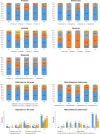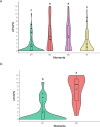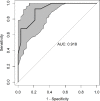Validation of the Unesp-Botucatu pig composite acute pain scale (UPAPS) in piglets undergoing castration
- PMID: 37053294
- PMCID: PMC10101451
- DOI: 10.1371/journal.pone.0284218
Validation of the Unesp-Botucatu pig composite acute pain scale (UPAPS) in piglets undergoing castration
Abstract
To accurately assess pain and support broadly-based analgesic protocols to mitigate swine pain, it is imperative to develop and validate a species-specific pain scale. The objective of this study was to investigate the clinical validity and reliability of an acute pain scale (UPAPS) adapted for newborn piglets undergoing castration. Thirty-nine male piglets (five days of age, 1.62 ± 0.23 kg BW) served as their own control, were enrolled in the study and underwent castration in conjunction with an injectable analgesic administered one-hour post-castration (flunixin meglumine 2.2 mg/kg IM). An additional 10, non-painful female piglets were included to account for the effect of natural behavioral variation by day on pain scale results. Behavior of each piglet was video recorded continuously at four recording periods (24 h pre-castration, 15 min post-castration, 3 and 24 h post-castration). Pre- and post-operative pain was assessed by using a 4-point scale (score 0-3) including the following six behavioral items: posture, interaction and interest in surroundings, activity, attention to the affected area, nursing, and miscellaneous behavior. Behavior was assessed by two trained blinded observers and statistical analysis was performed using R software. Inter-observer agreement was very good (ICC = 0.81). The scale was unidimensional based on the principal component analysis, all items except for nursing were representative (rs ≥ 0.74) and had excellent internal consistency (Cronbach's alpha ≥ 0.85). The sum of scores were higher in castrated piglets post-procedure compared to pre-procedure, and higher than in non-painful female piglets confirming responsiveness and construct validity, respectively. Scale sensitivity was good when piglets were awake (92.9%) and specificity was moderate (78.6%). The scale had excellent discriminatory ability (area under the curve > 0.92) and the optimal cut-off sum for analgesia was 4 out of 15. The UPAPS scale is a valid and reliable clinical tool to assess acute pain in castrated pre-weaned piglets.
Copyright: © 2023 Robles et al. This is an open access article distributed under the terms of the Creative Commons Attribution License, which permits unrestricted use, distribution, and reproduction in any medium, provided the original author and source are credited.
Conflict of interest statement
The authors have declared that no competing interests exist.
Figures









References
-
- Rydhmer L, Zamaratskaia G, Andersson HK, Algers B, Guillemet R, Lundström K. Aggressive and sexual behavior of growing and finishing pigs reared in groups, without castration. Acta Agric Scand A Anim Sci. 2006;56: 109–119.
-
- Povod M, Lozynska I, Samokhina E. Biological and economic aspects of the immunological castration in comparison with traditional (surgical) method. Bulg J Agric Sci. 2019;25: 403–409.
-
- Prunier A, Bonneau M, Von Borell EH, Cinotti S, Gunn M, Fredriksen B, et al.. A review of the welfare consequences of surgical castration in piglets and the evaluation of non-surgical methods. Anim Welf. 2006;15: 277.
-
- Llamas Moya S, Boyle LA, Lynch PB, Arkins S. Effect of surgical castration on the behavioral and acute phase responses of 5-day-old piglets. Appl Anim Behav Sci. 2008;111: 133–145.
Publication types
MeSH terms
LinkOut - more resources
Full Text Sources

